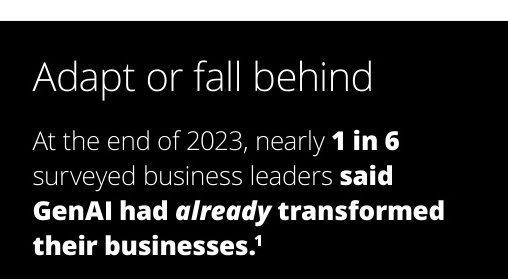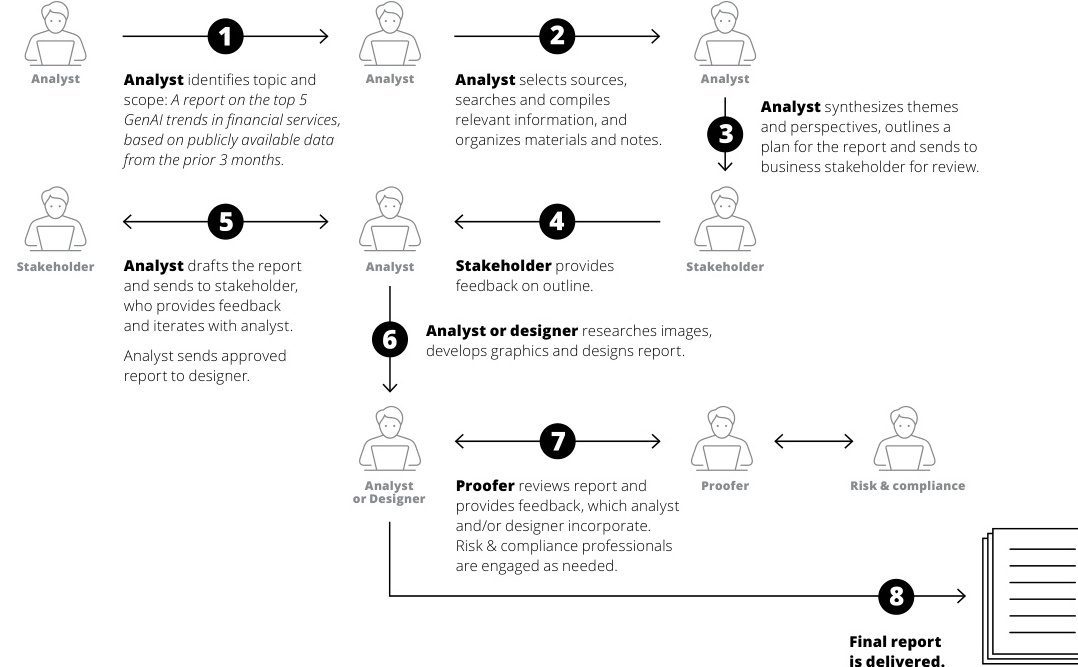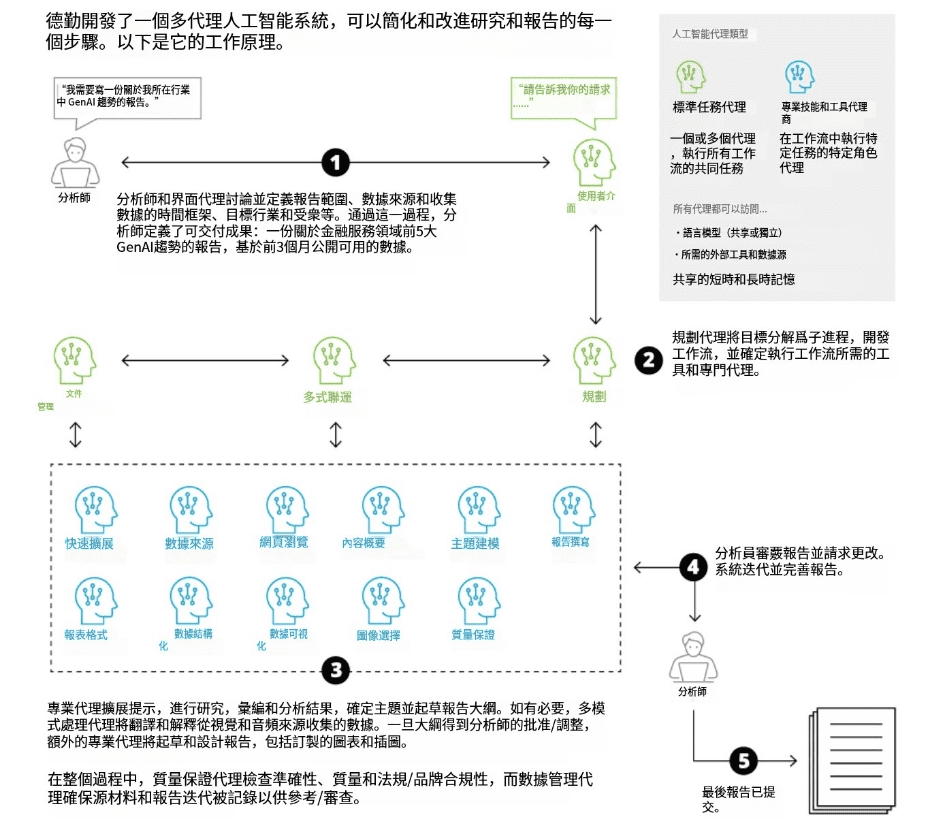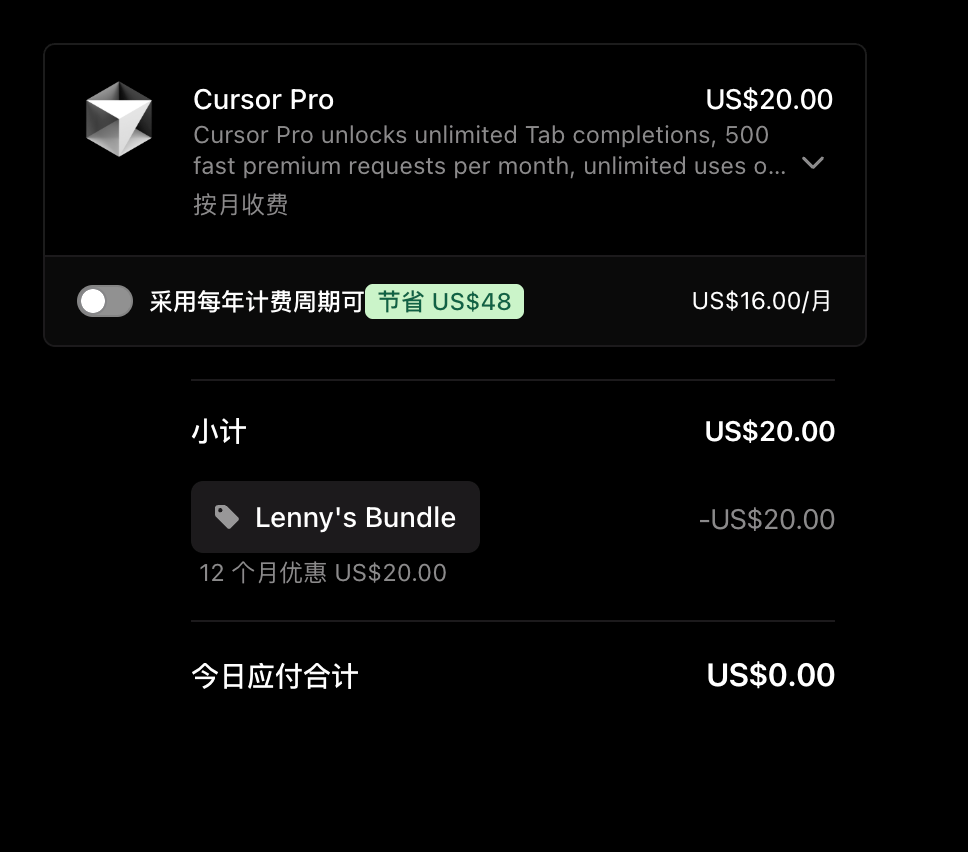Deloitte's Action Alert: How AI Agents Are Reshaping the Future of Work - Scalability of Generative AI, Use Cases, and Their Impact on the Enterprise
About Deloitte AI Institute
The Deloitte AI Institute™ helps organizations connect the different dimensions of the dynamic and rapidly evolving AI ecosystem. The Institute leads cross-industry discussions on applied AI innovation and provides cutting-edge insights to advance human-computer collaboration in the "Age of Collaboration".
The Deloitte AI Institute is dedicated to advancing the AI conversation and development, inspiring innovation, and exploring the challenges of AI implementation and ways to address them. Working with an ecosystem of academic research teams, startups, entrepreneurs, innovators, established AI product leaders, and AI visionaries, the Institute explores key areas of AI, including risk, policy, ethics, the future of work and talent, and the case for applying AI. Combined with Deloitte's extensive knowledge and experience in AI applications, the Institute helps demystify this complex ecosystem, providing influential perspectives that help organizations succeed through informed AI decisions.
No matter where you are in your AI journey, whether as a board member or C-level leader developing strategy for your organization or as a data scientist putting AI strategy into practice, the Institute can help you gain insights into how global organizations are using AI to gain a competitive advantage. Visit the Deloitte AI Institute to access our complete research, subscribe to our podcasts and newsletters, and attend our offline meetups and live events. Let's explore the future of AI together.

element
key point
- AI agents are reshaping industries by expanding the potential applications of generative AI (GenAI) and typical language models.
- Multi-agent AI systems can significantly improve the quality of output and the complexity of the work of a single AI agent.
- Forward-thinking organizations and governments are already implementing AI agents and multi-agent AI systems in a variety of use cases.
- Senior leaders should take immediate action to prepare for and embrace this new era of intelligent organizational transformation.
Introduction .......................................................................... .4
AI Agent:............................................................................. .5
Their differences and their importance
Multi-agent AI system:................................................................. .7
Enhancing the Potential of AI Agents
Key Benefits of AI Agents and Multi-Agent AI Systems:........................................ .7
The Benefits of AI Agents Unlocked for Today's Organizations
Strategic Insights Transformation:......................................................... .8
Real-world examples of multi-agent AI systems
Achieving Impact through Goal-Oriented Use Cases:............................................. .11
How AI Agents are Changing the Industry and Enterprise Sector
Enabling new ways of working and innovative horizons:.............................. .13
Impact on strategy, risk, talent, business processes and technology
The Road Ahead:....................................................................... .15
As AI agents continue to evolve, our expected
Roadmapping the next era of organizational transformation:........................ .16
Recommended actions for leaders to take now
Contact Info & Notes ................................................................ .17
summary
How can we operate faster and more efficiently?
This question has always been at the center of the strategic agenda, but Generative AI (GenAI) is helping us find new answers. By generating innovative outputs from natural language cues, GenAI enables organizations to significantly increase speed and productivity in all types of business tasks. However, application scenarios of typical language models are only beginning to show the transformative potential of GenAI. In this fast-moving AI era, it's time to think bolder: from streamlining routine tasks to redesigning entire workflows.
The new question now facing business and government leaders is:
How can we use GenAI to re-imagine business processes?
The Large Language Models (LLMs) and GenAI-based tools used in most organizations today serve primarily as useful assistants: prompted by human input, GenAI quickly generates output. However, this interaction is largely transactional and limited in scope.
What if GenAI could not only respond to requests, but also plan the entire process to help solve complex needs? What if GenAI also had access to the data, digital tools, and contextual knowledge needed to autonomously collaborate on the process from start to finish?
This vision is becoming a reality with the emergence of AI agents and multi-agent AI systems - they represent important advances in the potential for human-AI collaboration. Leading businesses and government agencies are already seeing the value of AI agents and putting them into practice.
In this paper, we will explore why AI agents are so groundbreaking. We will then reveal how they are reshaping the industry landscape, driving new application scenarios, enhancing automation, and accelerating the future of intelligent organizational transformation in industries including government and public services.
Adapt or fall behind: by the end of 2023, nearly one in six business leaders surveyed say GenAI has changed their business.
AI agents: what makes them different - and why it matters
To understand the potential value of AI agents and their role in scaling automation, it is first necessary to understand how they differ from the language models and GenAI applications familiar to today's business leaders.
AI agents are reasoning engines that can understand context, plan workflows, connect to external tools and data, and perform actions to achieve specific goals.
While this sounds similar to what a standalone big language model or GenAI application could do, there are key differences that make AI agents more powerful. (See table, p. 6.) For example, typical Big Language Model-driven chatbots are often limited in their ability to understand multi-step prompts, let alone plan and execute an entire workflow from a single prompt. They follow the "input-output" paradigm of traditional applications, which can be confusing when confronted with requests that need to be broken down into multiple smaller tasks. They also have difficulties in dealing with sequences of tasks, especially compound tasks that require consideration of temporal and textual context. These limitations are even more pronounced in Small Language Models (SLMs), as they often sacrifice computational cost and speed at the expense of knowledge depth and/or output quality in the presence of small amounts of training data.
As a result, early GenAI application scenarios were mostly limited to standalone applications, such as generating personalized ads based on customer search history, reviewing contracts and legal documents to identify potential regulatory risks, or predicting molecular behavior and drug-drug interactions in pharmaceutical research.
AI agents excel at coping with these limitations while also leveraging the capabilities of domain- and task-specific digital tools to effectively accomplish more complex tasks. For example, AI agents equipped with long-term memory are able to remember records of customer and public interactions - including emails, chats, and phone communications - to continuously learn and adapt personalized recommendations across digital channels. This is in contrast to large- and small-language models that are typically limited to conversational information. In addition, AI agents can automate end-to-end processes, especially in scenarios that require complex reasoning, planning, and execution.
AI agents are opening up new possibilities for enterprise productivity and project delivery through business process automation. GenAI application scenarios that were once considered too complex can now be realized safely and efficiently at scale.
In other words: AI agents are more than just interactions. They can reason and act more effectively on behalf of the user.
A new paradigm for human-computer collaboration
Through the ability to reason, plan, remember, and act, AI agents overcome key limitations of typical language models.
| Typical Language Models | AI Agent | |
| Scope of Application | Automated tasks | Automate the entire workflow/process |
| program | No ability to plan or coordinate workflows | Create and execute multi-step plans to achieve user goals and adjust actions based on real-time feedback |
| Memory and fine-tuning | No memory function, limited fine-tuning capability | Leverages short- and long-term memory to learn from past user interactions and provide personalized responses; memories can be shared among multiple agents in the system |
| Tool Integration | Not inherently designed to integrate with external tools or systems | Enhance the intrinsic ability of language models to perform tasks using APIs and tools (e.g., data extractors, image selectors, search APIs) |
| data integration | Dependent on static knowledge, training data has a fixed cutoff date | Dynamic adaptation to new information and real-time knowledge sources |
| accuracy | Often lacks self-assessment capabilities and is limited to probabilistic reasoning based on training data | Can utilize task-specific capabilities, knowledge, and memory to validate and improve their own output and that of other agents in the system |
Multi-agent AI systems: extending the potential of AI agents
While a single AI agent can deliver significant enhancements, the truly transformative power of AI agents is demonstrated when multiple agents work together. Such multi-agent systems are able to leverage the strengths of specific roles, enabling organizations to automate and optimize complex processes that would be difficult for a single agent to complete on its own.
Multi-agent AI systems employ multiple role-specific AI agents to understand requests, plan workflows, coordinate role-specific agents, streamline operations, collaborate with humans, and validate outputs.
Multi-agent AI systems typically include standard task agents (e.g., user interface and data management agents), as well as specialized skill and tool agents (e.g., data extractors or image parsing agents) that work together to achieve user-specified goals.
At the core of each AI agent is a language model that provides linguistic and contextual semantic understanding - the exact use of the same or different language models depends on the use case. This approach allows some agents to share knowledge while others cross-validate the output in the system, thus improving the quality and consistency of the process. Providing agents with shared short- and long-term memory resources further reduces the need for human cues during the planning, validation, and iteration phases.
This concept extends the possibilities of a single AI agent through a team or agency approach. By breaking down complex processes into multiple tasks, assigning them to agents specifically optimized to perform them, and coordinating agent-human collaboration at each workflow stage, such systems are more likely to achieve higher-quality, faster, and more reliable results.2,3
In other words: multi-agent AI systems can not only reason and act on behalf of their users, they can also coordinate complex workflows in minutes.
Key Benefits of Al Agent and Multi-Agent AI Systems
Capabilities - AI agents can automate interactions with multiple tools to perform tasks (e.g., navigating websites, quantitative computation) that cannot be done by standalone large language models.
Productivity - Compared to standalone large language models that require constant human input and interaction to achieve desired results, AI agents can plan and collaborate on complex workflows based on a single prompt, dramatically accelerating the delivery process.
Self-learning - By using short-term and long-term contextual memory resources (which are often not available in pre-trained language models), AI agents are able to rapidly improve the quality of their output over time.
Adaptability - As requirements change, AI agents can reason and plan new approaches, quickly reference new data and real-time data sources, and collaborate with other agents to complete and coordinate outputs.
Accuracy - A key benefit of multi-agent AI systems is the ability to use "validating" agents to interact with "generating" agents to test and improve quality and reliability as part of an automated workflow.
Intelligence - When agents focused on a specific task work together, each agent applies its memories, tools, and reasoning capabilities to bring machine-driven intelligence to new heights.
Transparency - Multi-agent AI systems enhance the ability to interpret AI output by demonstrating how agents reason and communicate collaboratively, providing a clear view of the collective decision-making and consensus-building process.
Strategic Insight for Change
Regardless of industry, every organization is involved in research, analysis, and reporting on a wide range of topics, including economic conditions, customer and stakeholder preferences, policies, and pricing strategies.
Traditionally, these projects have required skilled analysts to complete a multi-step process, including the use of research and analytical tools as well as in-house expert knowledge, and the entire process has been time-consuming.
The following is a typical process for a traditional research project.

Although this method is effective and reproducible, it is...
- Time-consuming: It can take days or weeks to complete a single report, making it difficult to capitalize on emerging opportunities.
- Inefficiency: Skilled analysts must perform many repetitive activities, weakening their focus on higher-level analysis.
- Difficulty in scaling up: companies and government agencies face challenges in recruiting and retaining enough skilled and experienced analysts to expand their research capabilities.
Deloitte has developed a multi-intelligence AI system that streamlines and optimizes every step of research and reporting. Here's how the system works.
 In addition to being efficient and reproducible, this AI agent-driven approach has...
In addition to being efficient and reproducible, this AI agent-driven approach has...
- Fast: A quality report can be generated immediately in less than an hour.
- Efficient: Professionals can focus on validating, iterating and refining reports.
- Highly scalable: in essence, the system provides an instant team of skilled digital workers.
Effective and efficient work relies on enhancing creativity and knowledge through well-planned processes and the right tools. This is where AI agents and multi-intelligence AI systems come in.
Achieving impact through targeted use cases
Organizations across industries are already leveraging the potential of AI agents and multi-intelligence systems to transform processes, improve efficiency, and extend reach. Let's explore four use cases that are currently possible - two industry-specific and two that can be applied to any business.
Case 1
Personalized Financial Counseling and Wealth Management
Industry: Financial Services
Financial advisory services typically rely on broad categorization of clients based on age, income and risk tolerance. This approach tends to ignore the complexity of individual financial situations and goals. In today's rapidly changing financial environment, there is a growing need for personalized, adaptive financial advice. Multi-intelligence AI systems can analyze diverse data sources-including a client's financial history, real-time market data, life events, and even behavioral patterns-to help advisors develop financial plans and investment strategies that are tailored to the individual. aI agents can also continually monitor and adjust advice as the environment changes. AI agents can also continuously monitor and adjust recommendations as the environment changes.
Potential benefits of using an AI agent to realize:
Ultra-personalized: financial advice is tailored to each client's specific needs and goals, taking into account factors that may be overlooked by other approaches.
Continuous fine-tuning: automatically updating financial plans and strategies in response to changes in market conditions or personal circumstances.
Enhance customer satisfaction: Strengthen customer relationships and increase customer retention and satisfaction by providing more relevant and timely advice.
Enhanced scalability: Provide high-quality, personalized advice to more clients without increasing the cost of service.
Case 2
Dynamic Pricing and Personalized Promotions
Industry: Consumer Markets
Standard pricing strategies often rely on static models that do not take into account real-time market conditions, customer behavior, or inventory levels. Multi-agent AI systems can quickly integrate analytics based on large amounts of real-time data, such as competitor pricing, customer purchase history and seasonal trends, to dynamically adjust prices. Additionally, they can personalize promotions based on each customer's preferences, characteristics, and shopping habits, aiming to increase conversion rates and boost customer satisfaction.
Potential benefits of using an AI agent to realize:
Faster adaptability: Adjust prices instantly to market changes, inventory levels or customer demand to optimize revenue.
Personalized Offers: Tailor promotions to each customer's preferences and behaviors to increase the likelihood of purchase.
Higher profitability: maximize margins and reduce discounts by continuously optimizing prices and promotions.
Case 3
Recruitment
Area: Human Resources (HR)
Traditional hiring processes often involve manual resume screening, repetitive candidate assessments, and extensive administrative work, leading to inefficiencies.AI agents can automate the end-to-end hiring process through natural language processing, including analyzing resumes, evaluating candidates based on skills and experience, and conducting initial interviews through generative AI-driven avatars. These systems can work with HR professionals to ensure that qualified candidates are quickly identified, prioritized, and efficiently progressed to subsequent stages of the hiring process while complying with regulations.
Potential benefits of using an AI agent to realize:
Increase efficiency: Automate tasks so HR teams can focus on strategic activities and shorten recruitment time.
Improved Candidate Matching: Analyze a wider range of data points to help more accurately match candidates to positions and improve the quality of hires.
Reduce bias: By standardizing candidate assessments and focusing on skills and experience, AI agents can help reduce unconscious bias in the hiring process.
Dynamic scalability: Handle large numbers of applications and make it easier to manage recruitment campaigns or recruit for multiple positions at once.
Case 4
Personalized Customer Support
Area: Client and beneficiary services
Traditional customer and beneficiary support systems often rely on scripted interactions that may fail to resolve complex or unique queries, leading to customer frustration and escalated issues. In contrast, multi-agent AI systems are able to understand natural language requests and generate relevant and natural responses based on customer history, preferences and real-time context. These advanced systems can efficiently handle many complex queries, reducing the need to transfer to human customer service while increasing customer/beneficiary satisfaction.
The potential advantages offered by artificial intelligence agents:
Higher consistency and scalability: AI agents can work 24/7 without fatigue and maintain consistent quality of service regardless of query volume.
Improved customer experience: each interaction with a customer can be tailored to individual needs, resulting in increased customer satisfaction and engagement.
Incremental efficiency: the ability to learn with each interaction helps to reduce response times, improve quality, and free up time for human service agents to focus on more complex customer requests.
Opening up new ways of working and innovative horizons
As language models continue to evolve, AI agents and systems are expected to become a strategic resource and efficiency enabler for core business and government activities (e.g., product development, regulatory compliance, customer service, constituent engagement, organizational design, etc.). We see a future where agents will revolutionize underlying business models and entire industries, driving new ways of working, operating models, and value delivery.
That's why it's important for senior leaders and public service leaders to prepare in advance for the next phase of human-computer collaboration and business innovation.
Let's explore some new ways of thinking and leading that should be considered in this time of rapid change.
strategic significance
Leaders should begin to integrate AI agents and multi-agent AI systems into their overall strategy and future roadmap. This means re-imagining business processes, investing in AI capabilities, and fostering a culture of innovation. Organizations should develop a clear roadmap for AI agent adoption, clearly identifying key areas that can maximize value drivers and impact broader business objectives.
Effective change management is critical to successful integration. Leaders should think carefully about how to address organizational resistance, provide training, and ensure employees understand the value and benefits of AI agents. This includes developing a comprehensive communication strategy to ensure that employees and other stakeholders are informed and remain engaged throughout the adoption process.
Areas of focus
-Identify and prioritize the business and service areas where AI agents can have the greatest and most immediate impact.
risk significance
Artificial intelligence agents pose new risks and require strong security and governance structures. A major risk is the potential bias in AI algorithms and training data, which can lead to unfair decision-making. In addition, AI agents may be vulnerable to data breaches and cyberattacks, which can jeopardize sensitive information and data integrity. The complexity of AI systems also brings with it the potential for unintended consequences, possibly due to AI agents exhibiting unpredictable behaviours or making decisions that are inconsistent with organizational goals.
To manage these risks, it is important to set clear parameters for agent interactions, monitor operational metrics, and continuously ensure data ethics, privacy, security, and integrity. As the integration of AI agents moves into core business processes, an enterprise-wide governance framework that includes guidelines on data use, ethics, and security will further help mitigate risks. The framework should ensure compliance with relevant regulations and include ongoing monitoring of AI agent interactions. Advanced security measures, such as encryption and multi-factor authentication, can help protect against data breaches and cyberattacks. Providing training and awareness programs for employees can provide additional protection by helping them understand the ethical and operational considerations of working with AI agents.
Areas of focus
-Identify brand and operational risks that may arise around data use, AI agents interacting with each other and with tools, ethics, etc.
-Ensure effective testing and validation of model outputs.
-Implement an AI agent governance framework that is regularly reviewed and updated to address the evolution of AI technologies.
-Monitor emerging risks specific to AI agents, such as "agent autonomy"-the risk of unintended consequences that can arise when agents make decisions with minimal human oversight.
-Develop strong training programs to help employees understand and use AI agents to improve productivity and efficiency.
significance of talent
The implementation of AI agents may change traditional labor structures. As AI agents take over routine and low-value tasks, the need for manual skills to design, implement, and operate these systems may rise dramatically. Leaders should think about what new roles, job descriptions, and position structures are involved in building these capabilities and how to identify, recruit, train, and retain this expertise.
Beyond the impact on technical talent, business leaders should also be prepared to help employees of all types learn how to work with AI agents and even identify new usage scenarios that can improve processes. If deployed and managed properly, AI agents can open up new areas of potential for human-computer collaboration-but that potential depends on employees understanding, embracing, and being able to perform their new roles.
Areas of focus
-Communicate the benefits of AI agents to help employees adapt to new ways of working.
-Foster a culture of innovation and continuous learning. Leaders should instill an innovative and adaptive mindset as it relates to AI agents.
-Explore redesigning job structures, workflows, and performance metrics to reflect the new reality of humans working in tandem with AI agents.
Impact of business processes
Artificial Intelligence Agents and multi-agent AI systems require careful human evaluation of business processes - sometimes from scratch. While agents will redefine many core processes over time, AI agents can be integrated into existing operating models today, enhancing the efficiency of current processes without the need for complete system re-engineering. This approach allows organizations to incrementally adopt low-risk agent solutions - but requires careful planning, management, and alignment to ensure that AI agents can enhance the parts that humans and/or other technology solutions already do well.
In those use cases where an AI agent does apply, human intervention remains critical, especially in tasks that require judgment, validation, and critical decision-making. This collaboration is critical to ensure that AI outputs are accurate, reliable, and effective. In this paradigm, all those working with the AI agent act as managers - issuing instructions via prompts, clarifying requests, monitoring progress, reviewing outputs and requesting or making changes as needed.
Focus areas
- Ensure that when agents are integrated into existing business processes, those processes remain effective while driving greater efficiency and value.
- Establish a process for continuously monitoring and improving the performance of AI agents. This includes collecting and analyzing AI agent performance data, identifying opportunities for improvement, and making changes as needed to optimize their performance.
Impact of technology and data
Implementing AI agents can be costly, involving significant technology and infrastructure investments. Organizations should carefully evaluate the value proposition and return on investment; and develop a phased approach to use cases, focusing on "low-hanging fruit" (i.e., simpler use cases) to lay the groundwork for more complex activations.
High-quality data is the foundation for AI agents to work effectively. If data is inaccurate, incomplete, or inconsistent, agent outputs and actions may be unreliable or incorrect - raising adoption and risk issues. Therefore, investing in strong data management and knowledge modeling is critical.
Adopting trustworthy AI practices is key to mitigating risks and ensuring ethical deployment. This includes developing fair, transparent, and accountable AI agent solutions and addressing potential biases in AI models.
Focus areas
- Build the right technology infrastructure to support the adoption and implementation of AI agents (e.g., AI orchestration platforms and scalable data lakes).
- Ensure that data is properly organized, up-to-date, and accessible to AI agents. This includes having clear data governance policies and processes in place and continuous access to real-time data streams for dynamic, accurate decision-making.
- Establish processes to monitor and manage the performance and ethics of AI agents and multi-agent AI systems. Without transparent and trustworthy AI, customer trust and compliance will be at risk.
The way forward
The era of artificial intelligence agent collaboration is still in its early stages. While interest from businesses and technology providers is growing, comprehensive solutions are not yet commonplace. A significant amount of technical work is needed - particularly in the areas of reasoning and planning capabilities - that will enable AI agents.
Improvements are likely to come quickly. In recent years, generative AI tools have made significant advances in their reasoning and agent orchestration capabilities. Many venture capital firms are investing extensively in technology areas related to AI agents, and many of today's leading generative AI and technology providers are investing more. What is currently available is just the tip of the iceberg for future developments. In fact, we expect core language models, AI agents and agent orchestration platforms to undergo significant evolution over the next 12 months.
Future-oriented leaders will not stand idly by. Across industries, many companies are already designing, testing, and in some cases implementing agents.
Leading a new era of organizational transformation
Artificial intelligence agents and multi-agent AI systems are more than just symbols of technological advancement. They represent a fundamental shift in how organizations automate processes, improve human-computer collaboration, generate insights and dynamically address complex challenges. They offer the potential to unlock tremendous value across multiple functional areas - from enhancing customer interactions and optimizing the supply chain to driving innovation in product development and service delivery.
The journey to realize these benefits requires thoughtful planning, strategic investment, and a commitment to fostering a culture that embraces continuous improvement and technological advancement. By aligning your AI agent program with your core business goals, investing in the right infrastructure, and fostering a culture of innovation, your organization can lead the way in this new era of AI-driven business transformation.
Now is the time to act.
Generative AI tools are growing rapidly - and this evolution is unlikely to slow down in the coming years. Similarly, AI agents are already being implemented by companies across industries as well as major technology providers. As a result, it is becoming critical to explore initial applications/use cases and lay the groundwork for future foundational business transformations.
To begin the journey of your own organization, consider the following actions:
1 Evaluate and prioritize use cases
Begin with a comprehensive assessment of current operations to identify high-impact areas where AI agents can add value. Focus on processes that lend themselves to automation, involve complex decision-making, and/or require rapid adaptation. Prioritize these use cases to achieve rapid success and demonstrate tangible value.
2 Develop a roadmap for strategic AI agents
Align your AI plan with broader business and mission objectives by developing a detailed roadmap outlining ways to integrate AI agents into operations. This plan should include clear milestones, timelines, and success metrics to guide the deployment of AI agent-driven capabilities across the organization.
3 Talent development Investment infrastructure and talent
Identify and build the infrastructure needed to support AI agents, including a scalable cloud platform, advanced data analytics tools, and robust cybersecurity measures. At the same time, invest in upgrading the skills of your workforce, with a focus on developing the technical capabilities to work effectively with AI agents and multi-agent systems. A well-prepared workforce is key to realizing the full transformational potential of AI agents.
4 Risk management Implement strong data governance
As AI agents become central to operations, it is important to establish a strong governance framework to manage the associated risks. Implement policies to ensure data integrity, security, and ethical use, while continuously monitoring AI interactions to guard against bias and adverse consequences. At the same time, compliance should always be a top priority.
5 Fostering a culture of innovation
Experimentation and continuous learning are critical to success. Encourage your team to explore new applications of generative AI and iterate on initial deployments to drive continuous improvement. By embedding innovation into your organization's culture, you can maintain a competitive edge in a rapidly changing business environment.
© Copyright notes
Article copyright AI Sharing Circle All, please do not reproduce without permission.
Related posts

No comments...




